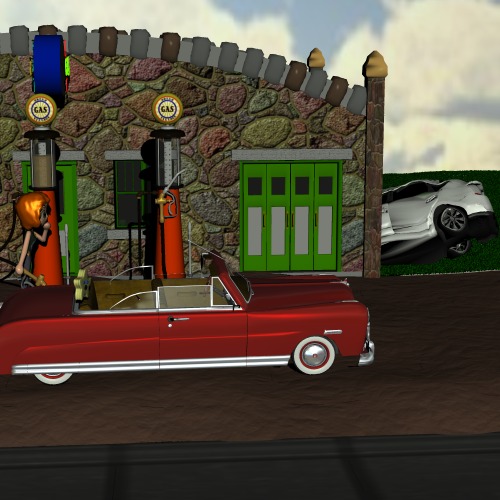Monday, February 08, 2010
Brakes will get you through times of no software...
...better than software will get you through times of no brakes.
Stopping is the most important thing a car does. If your car doesn't go, you can find other ways to get around. If your car doesn't stop, you're dead.
Henry Ford, one of Polistra's guiding lights, understood this. When other car makers were switching from mechanical to hydraulic systems, old Henry stuck with mechanical.

And the Hudson that Polistra is driving here had a hydraulic system for flexibility, backed up by a mechanical cable that took over when the fluid failed. Again it was one stubborn man who made the choice: engineer Stuart Baits developed and personally tested a hydraulic setup in the early '30s, and was badly injured when it failed. He vowed that nobody else would be hurt by such a failure, and added the mechanical backup system. Hudson kept faith until the end of the brand in 1957.
In today's industrial arrangement, one stubborn man doesn't count. Engineers are limited by lawyers and EPA on one side, and by the need to set up assembly for Chinese semi-slaves on the other.
Software solutions are tempting, with truly infinite flexibility and the capacity to navigate constraints. And our overall culture of business, government, education and science is totally engulfed by our insistence on trusting theories and software models rather than physical or mechanical reality. Toyota succumbed to that culture and is now paying the price.
Life is too important to trust multi-layered systems with multi-layered bugs.
= = = = =
Later: it appears that the Highway Safety Admin (NHTSA) may understand the difference between acceleration and steady speed even if nobody else does. They don't buy the "sticky pivot" explanation for Toyota's accelerator problem, and have been looking into electronic problems, perhaps interference from cell phones. (It's bad enough that the drivers are distracted by cell phones ... now the cars are distracted as well!)
Stopping is the most important thing a car does. If your car doesn't go, you can find other ways to get around. If your car doesn't stop, you're dead.
Henry Ford, one of Polistra's guiding lights, understood this. When other car makers were switching from mechanical to hydraulic systems, old Henry stuck with mechanical.

And the Hudson that Polistra is driving here had a hydraulic system for flexibility, backed up by a mechanical cable that took over when the fluid failed. Again it was one stubborn man who made the choice: engineer Stuart Baits developed and personally tested a hydraulic setup in the early '30s, and was badly injured when it failed. He vowed that nobody else would be hurt by such a failure, and added the mechanical backup system. Hudson kept faith until the end of the brand in 1957.
In today's industrial arrangement, one stubborn man doesn't count. Engineers are limited by lawyers and EPA on one side, and by the need to set up assembly for Chinese semi-slaves on the other.
Software solutions are tempting, with truly infinite flexibility and the capacity to navigate constraints. And our overall culture of business, government, education and science is totally engulfed by our insistence on trusting theories and software models rather than physical or mechanical reality. Toyota succumbed to that culture and is now paying the price.
Life is too important to trust multi-layered systems with multi-layered bugs.
= = = = =
Later: it appears that the Highway Safety Admin (NHTSA) may understand the difference between acceleration and steady speed even if nobody else does. They don't buy the "sticky pivot" explanation for Toyota's accelerator problem, and have been looking into electronic problems, perhaps interference from cell phones. (It's bad enough that the drivers are distracted by cell phones ... now the cars are distracted as well!)
